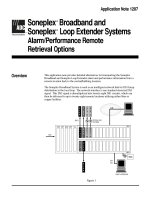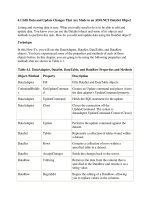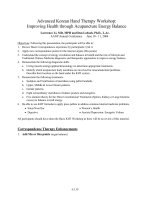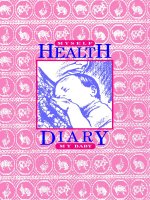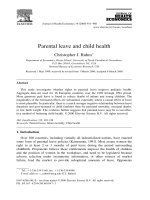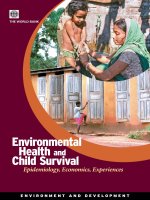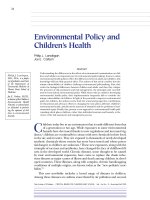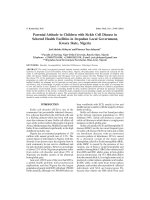Tài liệu Alberta Health and Wellness Public Health Notifiable Disease Management Guidelines: Tuberculosis (TB) pdf
Bạn đang xem bản rút gọn của tài liệu. Xem và tải ngay bản đầy đủ của tài liệu tại đây (102.83 KB, 12 trang )
Alberta Health and Wellness
Public Health Notifiable Disease Management Guidelines January 2011
Tuberculosis (TB)
Case Definition
Confirmed Case
Demonstration on culture of Mycobacterium (M.) tuberculosis complex, specifically M.
tuberculosis, M. africanum, M. canetti, M. caprae, M. microti, M. pinnipedii or M. bovis (excluding
BCG strain)
OR
In the absence of culture proof, cases clinically compatible with active TB that have, for example:
chest x-ray changes compatible with active TB,
active non-respiratory TB (meningeal, bone, kidney, peripheral lymph nodes, etc.),
pathologic or post-mortem evidence of active TB or
favourable response to therapeutic trial of anti-TB drugs.
Clinical Case
Clinical findings compatible with active TB in the absence of bacterial proof.
Examples of clinical findings:
Chest radiograph changes compatible with active TB including idiopathic pleurisy with effusion
OR
Active extrapulmonary TB (meningeal, bone, kidney, peripheral lymph nodes, etc.)
OR
Pathologic or post-mortem evidence of active TB.
Suspect (Probable) Case
High index of suspicion of TB in whom empiric treatment is being contemplated.
New Case
No documented evidence or history of previously active TB.
Retreatment Case
[1]
Documented evidence or adequate history of previously active TB that was declared cured or
treatment completed by current standards
AND
At least 6 months have passed since the last day of previous treatment
[2]
AND
Diagnosed with a subsequent episode of TB that meets the active TB case definition
OR
Documented evidence or adequate history of previously active TB that cannot be declared
cured or treatment completed by current standards
AND
Inactive
[3]
for 6 months or longer after the last day of previous treatment
[2]
AND
Diagnosed with a subsequent episode of TB which meets the active TB case definition.
1 of 12
Alberta Health and Wellness
Public Health Notifiable Disease Management Guidelines
Tuberculosis January 2011
© 2003–2011 Government of Alberta 2 of 12
[1]
Prior to 2008 in Canada, re-treatment cases were known as relapsed cases.
[2]
If less than 6 months have passed since the last day of previous treatment and the case was not previously
reported in Canada, report as a re-treatment case. If less than 6 months have passed since the last day of
previous treatment and the case was previously reported in Canada, do not report as a re-treatment case.
Submit an additional “Treatment Outcome of New Active or Re-treatment Tuberculosis Case” form at the end of
treatment.
[3]
Inactivity for a respiratory TB case is defined as 3 negative TB smears and cultures with a 3 month duration of
stability in serial chest radiographs or in the event of overseas screening, the absence of mycobacteriology and
a 6 month duration of stability in serial chest radiographs. Inactivity for a non-respiratory TB case is to be
documented bacteriologically, radiologically and/or clinically as appropriate to the site of disease.
Alberta Health and Wellness
Public Health Notifiable Disease Management Guidelines
Tuberculosis January 2011
© 2003–2011 Government of Alberta 3 of 12
Reporting Requirements
1. Physician/Health Practitioner
Physicians, health practitioners and others listed in Section 22 of the Public Health Act shall notify
the Medical Officer of Health (MOH) (or designate) in the prescribed form by mail, fax or electronic
transfer within 48 hours (two days) of identification of:
any case confirmed by culture, TB Probe or PCR and
clinical and suspect cases in whom empiric treatment is being contemplated.
2. Laboratories
All specimens must be forwarded to the Public Health Laboratory of Public Health (PLPH) for
smear and culture identification and susceptibility testing. The PLPH must report positive smear
and culture results to the zone MOH or First Nations and Inuit Health (FNIH) MOH if the individual
lives in a reserve community. Reports must also be sent within 48 hours (two days) to the:
Attending physician
AND
The Medical Director of the Edmonton Health TB Clinic if the individual lives in the Edmonton
Zone
OR
The Medical Director of the Calgary TB Clinic if the individual is from the Calgary Zone
OR
The Alberta Health Services (AHS) TB Medical Consultant if the individual lives outside of
Calgary or Edmonton or if the individual lives on reserve.
3. Alberta Health Services
The MOH (or designate) is responsible for reporting, follow-up and shall conduct investigation
activities.
Confirmed
, clinical and suspect cases that may be cause for community concern (e.g., smear
positive case on a plane or an infectious case with multiple contacts and high probability of
transmission) shall be reported to the Chief Medical Officer of Health (CMOH) (or designate)
by fastest means possible (FMP).
Confirmed
cases of multi-drug resistant (MDR) and extremely drug resistant (XDR) TB shall be
reported to the OCMOH by FMP.
The MOH (or designate) shall notify the appropriate TB Specialist (AHS Provincial TB Consultant,
or Medical Director, Edmonton or Calgary TB Clinics) within 48 hours of receiving the case report
for all remaining confirmed
, clinical or suspect. Notification will include:
name of individual (full name and any aliases if known),
date of birth,
country of birth,
personal health number,
address of individual,
phone number of individual,
date of any tests (including TST, AFB specimen collection, radiographic investigations), etc.
any identified high risk medical conditions, and
signs and symptoms consistent with active TB.
For out-of-zone, out-of-province or out-of-country reports, the MOH (or designate) shall notify AHS
Central TB Services by phone or fax. The following information should be included:
name (full name and aliases if known),
Alberta Health and Wellness
Public Health Notifiable Disease Management Guidelines
Tuberculosis January 2011
© 2003–2011 Government of Alberta 4 of 12
date of birth,
country of birth,
out -of-province health care number (if applicable),
out-of-province/regional address and phone number,
attending physician (both in and out-of-province/zone), and
results of any laboratory / radiology reports.
4. Additional Reporting Requirements
Citizenship and Immigration Canada (CIC): All immigration applicants, refugees or students
who plan to remain in the country for more than six months, and certain visitors are required to
undergo an immigration medical at their point of application. Those applying from outside of
Canada, with evidence of active disease are denied entry until treatment has been completed.
Individuals who do not have active disease but have a past history of TB and those who have
evidence of past disease on their chest x-ray are reported to AHS Central TB Services. As a
condition of entry, these individuals are required to report to or be contacted by a public health
authority within at least 30 days of their arrival in Canada.
Alberta Health and Wellness
Public Health Notifiable Disease Management Guidelines
Tuberculosis January 2011
© 2003–2011 Government of Alberta 5 of 12
Etiology
Mycobacterium tuberculosis is the etiologic agent of TB in humans.(2) The organism is a slightly
curved bacillus, 0.2 to 0.5 micrometres in diameter and approximately two to four micrometres in
length.(3) Mycobacteria are aerobic, non-spore forming and non-motile.(2) Growth rates are very
slow, with a doubling time of 15–20 hours.(2;4)
Other mycobacteria, including M. bovis, M. africanum, M. microti, M canetti, M caprae, and M
pinnipedii are also capable of producing disease in humans,(4) but these organisms are very rare in
Alberta and Canada. Generally, the many other environmental mycobacteria found in nature are
infrequent causes of disease in humans.(5)
Clinical Presentation
While TB usually presents as respiratory disease,(4) M. tuberculosis can cause disease in almost any
organ system.(4;6) Clinical presentation varies greatly depending on the site of disease. Symptoms
usually begin insidiously and progress over a period of many weeks or months prior to diagnosis.
Systemic symptoms consistent with TB include:
weight loss,
fever,
night sweats,
fatigue or weakness.(1)
Symptoms of respiratory TB:
persistent cough (of three weeks or more),
sputum production, sometimes with hemoptysis
chest pain (TB pleurisy) , and
shortness of breath.(3)
Symptoms of non-respiratory TB are dependent on the site affected.
TB of the spine might produce back pain.
TB of the kidney may cause flank pain, frequency and dysuria.
TB of the lymph nodes can result in lymphadenopathy (which may be painful if enlargement
occurs rapidly).(7)
The majority of persons with extrapulmonary TB have concurrent pulmonary TB.(7)
Diagnosis
Definitive diagnosis of TB disease is made by isolation of the Mycobacterium tuberculosis (MTB) in
culture.
Culture for MTB is considered the gold standard in diagnosis.(2;4;8) Because M. tuberculosis
grows slowly, it may take up to seven weeks(1) to show definitive culture positive results.
The use of the BACTEC system, a liquid culture system, allows for more rapid growth of
bacteria of the M. tuberculosis complex.(4)
DNA probes are used to differentiate M. tuberculosis complex, from environmental
mycobacteria. Results can be available within two hours, but the probe can only be used once
positive cultures have been identified.(8)
Because it is not always possible to culture M. tuberculosis, a clinical diagnosis of TB is made in
approximately 15–20% of cases on the basis of appropriate clinical and/or radiological and/or
pathological presentation as well as treatment response.(8)
Alberta Health and Wellness
Public Health Notifiable Disease Management Guidelines
Tuberculosis January 2011
© 2003–2011 Government of Alberta 6 of 12
Epidemiology
Reservoir
The reservoir for M. tuberculosis is humans.(8) The reservoir for M. bovis is animals.(6)
Transmission
Infection is transmitted almost exclusively by inhalation of the tubercle bacillus in droplet form.(4)
Droplet nuclei are created by individuals through coughing, sneezing, singing, and other forceful
expiratory efforts.(4) Duration of exposure needed for transmission is usually prolonged, but in
highly infectious individuals, duration can be as short as a few seconds, or a few minutes.(8)
Person-to-person transmission of M. tuberculosis is determined by certain characteristics of the
source-case and of the person exposed to the source-person and by the environment in which the
exposure takes place. The virulence of the infecting strain of M. tuberculosis might also be a
determining factor for transmission.(9) The usual route of transmission of M. bovis is in
unpasteurized milk from a diseased animal.(6)
Incubation Period(8)
Tuberculin skin test (TST) conversion occurs within 8 weeks of exposure and infection. Infection
may persist lifetime as latent infection. The risk of progression from infection to disease is
greatest within two years after infection (5% in otherwise healthy individuals). There is a further
5% risk of progression to disease over an individual’s lifetime. Age less than five years and
certain medical conditions will increase this risk substantially (see host susceptibility).
Period of Communicability
As long as viable tubercle bacilli are being aerosolized, untreated or inadequately treated
individuals with active respiratory disease are contagious. Adequate treatment with drugs renders
most individuals non-infectious within a matter of weeks.
Young children with active pulmonary TB are often not infectious. (6)
Non-respiratory TB is not usually infectious.(6)
Host Susceptibility
Individuals are most susceptible if they have not had prior exposure to M. tuberculosis.(6)
Prior infection in immunocompetent individuals provides some protection against future infections,
especially if prior infection gave rise to TB disease.(10)
Several medical conditions place individuals, once infected, at high risk of disease. These
include:
HIV/AIDS – dual infection with HIV is the most important risk factor for the development of
disease. The annual risk of active disease varies from 3 to 13%; risk increases as the CD4
counts falls.
transplantation,
silicosis,
chronic renal failure requiring hemodialysis,
carcinoma of the head and neck,
abnormal chest radiograph – fibronodular disease,
recent TB infection (≤ 2 years),(7)
steroid use, and
Alberta Health and Wellness
Public Health Notifiable Disease Management Guidelines
Tuberculosis January 2011
© 2003–2011 Government of Alberta 7 of 12
hematological malignancies.(11)
Occurrence
General
Currently, TB is the second highest cause of death from an infectious disease worldwide,(12)
after HIV/AIDS, and is the top killer of people infected with HIV.(4;8;12)
Globally, incidence rates of TB are increasing.(13) In 1993, the World Health Organization
declared TB a ‘global emergency’.(14) In 2008, the global rate was estimated at 139 cases
per 100,000 population, with 9.4 million new cases reported.(13) Many developing countries
experience great difficulty with treatment and control of the disease, as a result of inadequate
public health and TB control programs, widespread poverty, and the spread of the HIV
epidemic.(4)
The emergence of drug resistant strains is becoming an increasingly worrisome problem
worldwide.(8;15;16) It represents a problem not only in treatment of the active case, but in
their contacts as well.(16)
Canada
Canada continues to have one of the lowest reported rates of TB in the world.(13) Although
TB is relatively uncommon among the general population, it continues to be a significant
communicable disease of concern among certain higher-risk groups, including Aboriginal
peoples, foreign-born residents from countries with a high prevalence of TB(8), disadvantaged
inner-city populations and those with HIV infection.(3) In 2008, the Canadian TB rate was 4.8
per 100,000.(17)
Alberta
Since 1993, Alberta’s annual rates for active disease have consistently been lower than the
national rates. In 2007, the Alberta rate was 3.2 per 100,000 and in 2008, the Alberta rate was
4.7 per 100,000.(17)
As immigration from TB endemic countries increases, the rate in Alberta can be expected to
increase.
Key Investigations(11)
Assess risk of transmission to others by reviewing newly diagnosed cases, specifically for:
Symptoms which may indicate pulmonary or laryngeal TB (with aerosolization) – specifically
cough or hoarseness: pulmonary and laryngeal TB are infectious, but nonrespiratory TB is
generally not.
Duration of symptoms, especially cough - this will assist in determining how long the individual
has been infectious.
Places that the individual has been since the symptoms began, especially those places where
they spent the most time, including information about the characteristics of each place such as
size, ventilation, and length of time spent there.
There is more risk in a small, enclosed, poorly ventilated room than a large, well-ventilated
one.
Contacts – names, approximate date of birth, addresses and telephone numbers of individuals
they have spent time within each of the places identified, especially those they had daily
contact with. Very high-risk contacts include children less than 5 years of age, those with
immunocompromising conditions, and those with symptoms suggestive of active TB disease
(potential source or secondary cases).
Alberta Health and Wellness
Public Health Notifiable Disease Management Guidelines
Tuberculosis January 2011
© 2003–2011 Government of Alberta 8 of 12
Consultation with Central TB Services or the appropriate TB Clinic will give further information
about the risk of transmission.
Results of sputum smear and cultures for AFB. Individuals whose sputum is smear- positive
are more infectious than those whose sputum smears are negative.
Chest radiograph findings – cavitary lesions suggest highly infectious disease.
TB treatment – degree of infectiousness decreases rapidly once an appropriate treatment
regime is started.
The susceptibility of the contact –individuals who have had no prior exposure to TB are more
susceptible to infection.
Control(11)
Management of a Case
Management of active TB disease in Alberta involves a partnership between the patient, their
physician, the zone MOH and/or FNIH MOH and AHS Central TB Services or Edmonton TB Clinic
or Calgary TB Clinic.
AHS Central TB Services provides AHW funded medications at no cost to all patients in the
province, and monitors compliance with, and response to treatment.
Patients who are smear positive and/or culture positive respiratory TB cases are placed into
respiratory isolation.
Recalcitrant patients can be detained for treatment of active, infectious disease under the
Public Health Act.
AHS maintains a registry of all individuals who have been diagnosed with active TB as well as
those with latent TB infection (LTBI).
All individuals with newly diagnosed TB should undergo HIV testing. Ideally, HIV testing should
be performed at the time of diagnosis of TB or during the period of activity of TB.
Treatment of a Case
The goals fo
r treatment of active TB disease benefit the individual with TB and the community in
which they live by:
relieving symptoms,
preventing further transmission of TB,
preventing development of drug resistance, and
achieving lifetime cure of the disease for the treated individual.
Curing TB can be achieved in a variety of ways, all of which require the use of medications to
which the organism is susceptible. Anti-TB drugs are always given in combination for a period of
several months, and in general follow a two-phase regimen.
During the initial (intensive) phase (also called “front-end-loading”), four or five(1) anti-TB
medications are used in combination to:
relieve symptoms,
rapidly reduce the number of MTB organism present and interrupt transmission, and
prevent the development of drug resistance.
The continuation phase is aimed at eliminating any remaining MTB organisms and ensuring
lifetime cure (no relapse). This phase typically includes fewer medications than the initial phase,
and is usually given on an intermittent (twice-weekly) basis for an additional four to seven months.
Longer courses of treatment may be required for some forms of TB disease, such as those
involving the central nervous system, miliary or disseminated TB, and bone and joint TB, or if
standard first-line TB medication can not be used.
Alberta Health and Wellness
Public Health Notifiable Disease Management Guidelines
Tuberculosis January 2011
© 2003–2011 Government of Alberta 9 of 12
Patients receiving treatment should be monitored for drug side effects and response to treatment
according to prescribed protocols.
There are some instances where special considerations need to be taken into account for TB
treatment, including pregnancy, breastfeeding, pediatric individuals, people living with HIV, renal
failure, concurrent hepatic disease/risk, nonrespiratory TB and cases of drug resistant TB (DR-
TB).
Directly observed therapy (DOT) is the most effective way to monitor treatment adherence. (7) A
trained health care worker or other designated individual (excluding a family member) provides the
prescribed anti-TB drugs and watches the individual swallow every dose. Studies show that
86–90% of TB cases receiving DOT complete therapy, compared to 61% for those on self-
administered therapy.(17) In Alberta, all active TB cases receive DOT. This encourages
individuals to finish TB treatment as quickly as possible, without unnecessary interruptions;
decreases in the risk of drug-resistance resulting from erratic or incomplete treatment; and
decreases the chances of treatment failure and relapse. This also helps prevent TB from
spreading to others.
Management of Contacts
Whenever an individual is found to have active infectious TB, a contact investigation is initiated
to determine whether others may have active disease or are infected without disease. Those
who are infected without disease should be offered preventive therapy.
Contact investigation begins with contacts found to be at high risk for infection (e.g. close
household or close non-household contacts) and/or high risk for progression to disease (e.g.
children less than 5 years of age, immune-suppressed contacts) and is expanded according to
need (using concentric circle approach). The initial investigation consists of an interview with
contacts to determine their risk of infection.
At present the major tool for diagnosis of TB infection is the tuberculin skin test (TST),
consisting of the intradermal injection of a small amount of purified protein derived from M.
tuberculosis bacilli. In most cases, infected individuals will show significant localized
induration at the test site within 48 to 72 hours.
TST is performed on contacts with no previous documentation of TB or a significant reaction to
TST in the past. It is performed as soon as possible after contact. Conversion of TST from
negative to positive can take up to 8 weeks after infection occurred, and therefore, if initial test
is done within 8 weeks of last exposure to an infectious case, and is not found to be positive, a
second test should be performed at least 8 weeks after the last exposure occurred.
If the result of either test is significant, further investigation with chest radiographs and sputum
investigation are necessary. Young children (<5 years of age) require clinical and radiographic
investigation regardless of the TST results. Consultation with a TB specialist is critical.
Ultimately, the TST may be replaced by or used in conjunction with an interferon gamma
release assay (IGRA), a blood test assay that detects the presence of T-lymphocytes that
have previously been exposed to M. tuberculosis antigens. These assays offer advantages
over the TST; they appear to minimize false-positive test results due to vaccination with BCG,
require only a single visit by the patient and pose no risk of serious skin or allergic
reactions.(7)
Active TB in young children signals a recent infection and indicates the probability of an
undiagnosed case amongst the child’s close contacts. Therefore, when disease is diagnosed
in children, contact investigation attempts to identify the source case.
Alberta Health and Wellness
Public Health Notifiable Disease Management Guidelines
Tuberculosis January 2011
© 2003–2011 Government of Alberta 10 of 12
Preventive Measures
All individuals who are admitted to active treatment facilities (e.g., acute care hospitals) with
suspected or confirmed infectious TB must be isolated until proven to be non-infectious.
Prevention efforts are directed at ensuring that once an individual has been infected with the
tubercle bacillus, the infection (LTBI) does not progress to disease. This is achieved through
the use of TB medication.
Without intervention, approximately 5% of newly infected individuals will develop active TB
within two years. If the newly infected individual is a child or is immunocompromised, this
percentage is much higher.
Medications used to treat LTBI are the same as those used to treat TB disease, but the use of
a single drug is acceptable practice because the bacterial population is much lower in infection
compared to disease. Treatment regimens may take anywhere from four to nine months to
complete, depending on the drug chosen.
The usage of Bacille Calmette-Guérin (BCG) vaccine is limited to select population groups in
only a few areas of Canada at this time. In many TB endemic countries it is still used
extensively. It may interfere with the ability to interpret the tuberculin skin test.
Individuals at higher risk for infection (i.e., healthcare workers or travelers with direct patient
contact in high-risk facilities or performing high-risk procedures) receive routine serial
tuberculin skin testing to ensure early diagnosis of latent infection and the provision of
treatment.
Alberta Health and Wellness
Public Health Notifiable Disease Management Guidelines
Tuberculosis January 2011
© 2003–2011 Government of Alberta 11 of 12
References
(1) Dr.Richard Long, TB Medical Consultant. Personal Communication. 2010.
(2) Todar K. Mycobacterium tuberculosis and tuberculosis. Textbook of Bacteriology
2008Available from: URL: />
(3) Dyer CA. Tuberculosis. Santa Barbara, CA: Greenwood Press; 2010.
(4) Fitzgerald DW, Sterling TR, Haas DW. Mycobacterium tuberculosis. In: Mandell GL, Bennett
JE, Dolin D, editors. Mandell, Douglas and Bennett's principles and practice of infectious
diseases. 7th ed. Phildelphia, PA: Churchill Livingston; 2010. p. 3129-63.
(5) Tuberculosis. In: Pickering LK, Baker CJ, Kimberlin CW, Long SS, editors. 28th ed. ed. Elk
Grove, IL: American Academy of Pediatrics; 2009. p. 680-701.
(6) Tuberculosis. In: Heymann DL, editor. 19th ed. Washington, DC: American Public Health
Association; 2008.
(7) Tuberculosis Component of Techinical Instructions for the Medical Examination of Aliens in the
United States. U S Department of Health & Human Services 2008 May; Available from: URL:
/>
(8) Public Health Agency of Canada. Canadian Tuberculosis Standards. 2007. 6-30-2010.
Available from: URL: />
(9) Controlling Tuberculosis in the United States; Recommendations from the American Thoracic
Society, CDC, and the Infectious Diseases Society of America. MMWR 2005 November 4.
54(RR12):1-81. Available from: URL:
/>
(10) Watt CJ, Hosseini SM, Lonnroth K, Williams BG, Dye C. The global epidemiology of
tuberculosis. In: Schaaf HS, Zumla A, editors. Tuberculosis: a comprehensive clinical
reference.Edinburgh, UK: Elsevier Sanders; 2009. p. 17-27.
(11) Alberta Health and Wellness. Tuberculosis Prevention and Control Guidelines for Alberta.
Government of Alberta Website 2010 June;Available from: URL:
/>
(12) Young DB, Perkins MD, Duncan K, Barry CE I. Confronting the scientific obstacles to global
control of tuberculosis. J Clin Invest 2008 Apr;118(4):1255-65.
(13) World Health Organization. Global Tuberculosis Control: A short Update to the 2009 Report.
World Health Organization 2009;Available from: URL:
/>
(14) National Foundation for Infectious Diseases. Tuberculosis: A Global Emergency. National
Foundation for Infectious Diseases 2006;Available from: URL:
/>
Alberta Health and Wellness
Public Health Notifiable Disease Management Guidelines
Tuberculosis January 2011
© 2003–2011 Government of Alberta 12 of 12
(15) Shah NS, Wright A, Bai GH, et al. Worldwide emergence of extensively drug-resistant
tuberculosis. Emerg Infect Dis 2007 Mar;13(3):380-7.
(16) World Health Organization. Guidelines for the Programmatic Management of Drug-Resistant
Tuberculosis. World Health Organization 2008;Available from: URL:
/>
(17) Public Health Agency of Canada. Tuberculosis in Canada: 2008 Pre-release. Public Health
Agency of Canada website 2010;Available from: URL: />latb/pubs/tbcan08pre/index-eng.php
